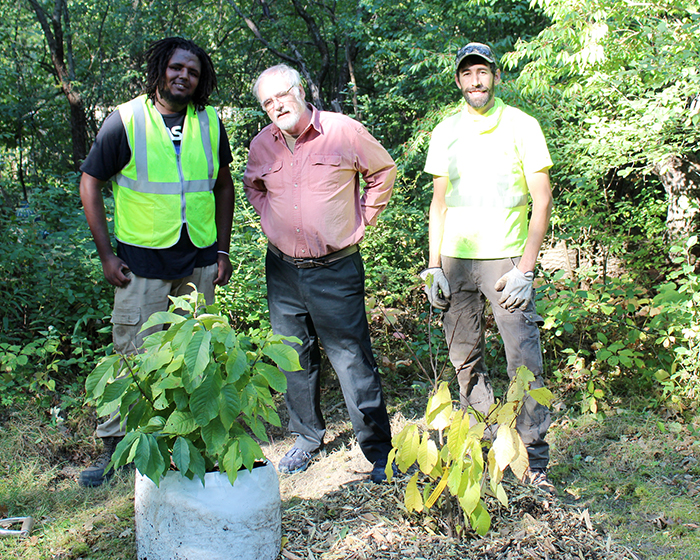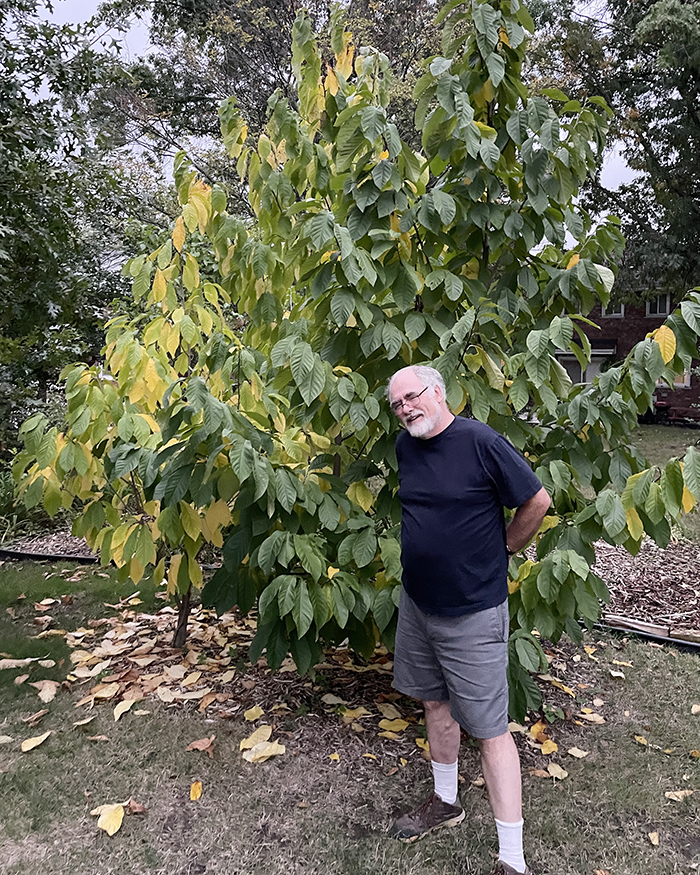
For the first time, pawpaw trees can be found in public spaces around Flossmoor.
That is thanks to a $1,000 donation from Tom Houlihan to the village, which has purchased 17 of the native trees and is in the process of planting them in five different locations. Village arborist Dave Becker is among those happy about the generosity.
“It’s a great donation from Tom,” Becker said. “We’re definitely excited about it.”
Houlihan has three pawpaws in his backyard. Both he and Becker said a few other residents have them, too, but this is the first time they will appear in village-owned spaces.
“It’s great to see the pawpaw trees going into the village,” Becker said. “They’re unique, a different tree.”
The pawpaws are being planted near the Heather Hill detention basin, in the Sterling Avenue right-of-way, the Butterfield Road right-of-way, along the bicycle path at the end of Dartmouth Road and in the Thornwood Drive island. Becker said those locations will give them an opportunity to spread, fill in and form colonies. Houlihan noted they pollinate each other, so it is important that they grow close together, as the pollination has to come from another pawpaw tree.
Naturally, they grow in bottomland forests as understory trees that like shade and wet areas, Becker explained. They thrive near floodplains.
“We did plant these trees in locations that meet the requirements,” Becker said. “These will be low-maintenance trees once established. We will be watering them regularly during their establishment period, which is this fall and next year. They will take care of themselves once they have their established root systems.”
While the pawpaw typically grows wild in the South, it is the farthest north-growing member of a tropical tree family, according to a social media post from the village. Unlike most species of fruit trees, which were cultivated abroad and brought to the United States, pawpaws are native to America. They start small and skinny, and though Becker noted they can eventually get to be 20 feet tall, Houlihan added they don’t get much wider.
“They’re real skinny,” Houlihan said. “They’ll always be real skinny. They’re sort of odd, but they’re very, very interesting.”
Flossmoor officials expect the trees to provide a number of benefits, including tropical fruits.
Mayor Michelle Nelson said their fruit is delicious. The first time she had it, it actually came from one of Houlihan’s trees.
“I’d never heard of the fruit until a neighbor happened to share one from the Houlihans’ yard with me,” Nelson said. “I’m excited for current and future residents to learn about the trees and taste the fruit.”
Houlihan warned that could be a while. After he planted the three trees in his backyard, they took 6-7 years to bear fruit. But he said the wait is worth it.
“They really do taste good,” Houlihan said. “They’re sweet. They’re custardy. They have a really unique flavor. Whenever I give them to anybody, they are just knocked out by the taste.”
Houlihan said he first got interested in the trees because his wife, Patty, had been to Paw Paw Lake in Michigan. He started to realize how many places in the Midwest had variations of that name and researched it. What he found is that all of the names were all based on this tree.
“They’re this legendary tree,” Houlihan said.
Pawpaws are considered semi-tropical, he said, often growing near rivers in the South. But Houlihan’s research also led him to something that said Chicago is the farthest north they will grow wild. So, he decided to give it a try. They are not hard to cultivate, he said.
“If I can grow them, anyone can grow them,” Houlihan quipped.
He has done some pollination experiments, noting the trees are pollinated by flies instead of bees. They show blood red flowers around April, and after they are pollinated there are buds. The fruit goes from roughly the size of an eraser to the size of a potato when all goes according to plan, Houlihan said. This year, he harvested 25-30 pieces of fruit from his trees, which he said is not bad, but he was hoping for more after spotting hundreds of buds.
“I keep waiting for the bumper crop to happen,” he said. “Like a lot of things in life, it was an accident that it turned out as well as it did.”
Houlihan got his pawpaws from Possibility Place Nursery in Monee, which specializes in native species. The village used the same source. Houlihan said the idea to spread the wealth started to materialize after he sent a note to Village Manager Bridget Wachtel to pitch the idea of a donation in an effort to expose more people in town to the trees.
“I’ve been thinking about this for the last year, to give some money to the village so they could get some pawpaws,” Houlihan said. “The main purpose why I did it is I thought it would be good for the town and I thought the town will benefit from having something that is really a unique American tree.”
The planting started at the end of September, and Becker said they were hoping to get more in the ground the first couple weeks of October. Houlihan said it has been a pleasure to see it all come together.
“It was real exciting,” he said. “It made me feel great. I think it’s good for the town that they have these things. This is a very tree-centric community, but except for a few people’s backyards there’s none of these. I thought this would be a really interesting tree for the village to have.”
Nelson called the Houlihans “gems in this community of doers.”
“The generosity of residents like the Houlihans is part of what makes Flossmoor such a beautiful village,” Nelson said. “I love it when neighbors share their passions and interests with all of Flossmoor.”
Houlihan has spent 18 years in his Flossmoor home. In addition to the pawpaws, he has a couple of oaks, blue beech trees and a catalpa. He also planted serviceberries in an effort to attract cedar waxwings, which like the fruit.
“We try to attract as many birds as we can,” Houlihan said. “That’s one of the reasons we like having all the trees.”
Editor’s note: During his time as editor of the H-F Chronicle, Tom Houlihan occasionally discussed in his columns his interest in pawpaw trees.
- Our overhead canopy endures a freak storm, and waiting for backyard fruit to fall (Sept. 1, 2020)
- Planting trees when the world seems to be going to pieces (May 3, 2020)
- It’s paw paw pollination time, with dreams of homegrown ‘bananas’ (June 4, 2016)
- Harvest time as singular paw paw crop points toward future (Oct. 7, 2018)



